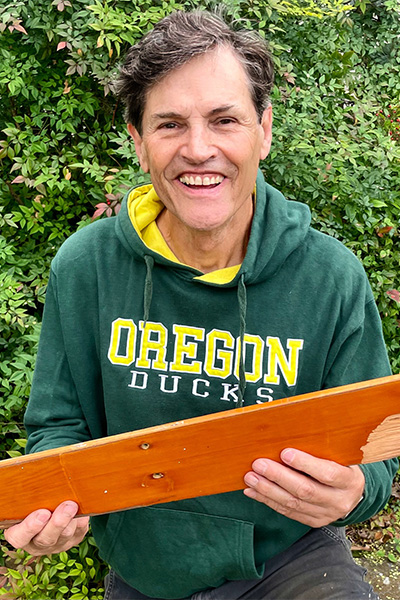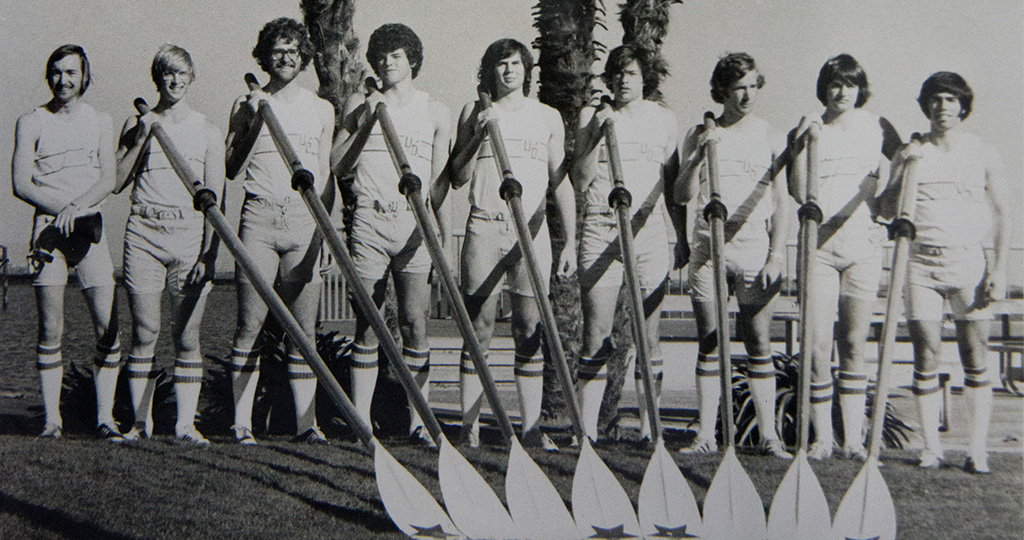March 26, 2024
Oregon rowers meet beauty and the beast on Dexter Lake
Dexter Reservoir, like any body of water, can be either a beauty or a beast. Located 20 miles southeast of Eugene on Highway 58 heading toward Oakridge, the surrounding hills contribute to its beauty and drew the Pac-12 Rowing Championships to its shores in 2023.Fifty years earlier, one unforgettable day in March of 1973, the beauty turned into a beast, whipped into its worst form by a sudden squall that descended upon the area. Five minutes before this ugly transformation took place, the UO crew coaches in the launch informed us that they were nearly out of gas and were going to the dock to get more fuel. We were told to row down to the covered bridge and then row back to the dock and they would meet us there.
As the varsity four-man boat, heavyweight freshman eight, and lightweight eight made their way to the east end of the lake, the sky was quickly turning into a moody collection of dark-gray clouds. Oregon’s first-ever women's eight was at the opposite end of the lake closer to the dam. While we turned our boats around to make the diagonal path across the lake from the bridge toward the dock, the wind velocity quickly increased, and the lake was immediately transformed into a large bowlful of sizable whitecaps.
All three boats were left to struggle back to safety, each coping as best they could as they took on water. The varsity four made more progress than the freshman eight and was soon out of view in the driving rain. The coxswain of the lightweight boat smartly directed the shell head-on into the wind westward toward the dam but still took on water, with every cold wave splashing onto bowman Gene Balcomb’s lower back.
With decisive instruction, the coxswain had Balcomb and the number two oarsman keep rowing while everyone else bailed water any way they could. Though it took about 25 minutes of effort with this strategy, the boat made it to the wind shadow of the dam. They sat out the storm there before rowing back to the dock under calmer conditions.
Meanwhile, the freshman eight was coxed by Doug Baker, while I rowed at the stroke oar. At Baker’s command, we pulled with all our might toward the dock into the strong wind for what seemed like 10 minutes. After much exertion, a quick glance to the shoreline revealed we had seemingly moved very little and were taking on considerable water due to the size of the whitecaps and velocity of wind. That’s when someone made the case that we weren’t getting anywhere rowing toward the dock and suggested we turn and row toward the shore.
Brilliant. Turn we did, and it didn’t take much for the whitecaps to hit us broadside and quickly swamp the boat. (This point among contributors to the story is debatable, whether we turned or the boat’s angle toward the dock exposed us to greater wave action.) We were literally sitting Ducks with our oars fixed in their oarlocks below the water’s surface, oarsmen waist deep, unable to move in any direction, and still about a football field’s length away from shore.
Has it been mentioned that this was a boat load of freshmen? The bowman, Mike Tuckman, stood on his seat to yell and wave toward shore, hoping to get the attention of local homeowners along the shoreline. Crew shells back then were made of thin veneers of wood with sealed air pockets at each end. All the boats were well-used and rented from Stanford and were George Pocock creations (of “Boys in the Boat” fame).
Within a few minutes, I noticed that Baker looked like he was sitting higher than me. This caused me to turn and look at the bow to see Tuckman sitting higher also. Most alarming was the sight of our six biggest oarsmen sitting in the middle of the boat up to chest deep in cold, mountain-fed, runoff waters. Under the weight of the oarsmen, perhaps the action of standing up and putting all weight in one point, and especially the constant pounding of the waves, the old boat had broken at the middle and made our circumstances perilous.
One of the guys declared, “I’m swimming to shore,” followed by a “me too.” We were within 100 yards to safety, and everyone followed those who had left the boat. With trepidation, I was last to leave the boat and within six strokes a strong cramp seized my right calf, but I managed to turn and make it back to the boat. About this time, the coxswain yelled out“I can’t swim!” Fortunately, Gary Young, the number seven man who rowed right behind me, was close by and took ahold of Baker’s collar to assist him.
Young, who was already tired, cold, and burdened by his water-logged sweats, was worried that if Baker couldn’t make it to shore by dog-paddling that either he would be lost or both of them would be lost in the rescue attempt. Fortunately, they both made it, but the shivering coxswain was one of two people who was taken to the emergency room with hypothermia that day.
The other individual, Craig Knechtel, was a junior in the varsity four, which did not make it to the dock either, but managed to make it to the county park’s shore by feathering their oars underwater before engaging in the “catch” of each stroke. Senior Dave Worthington was quite amazed, and pleased, that such a feat could be done.
Knechtel, who was a good swimmer and served as a lifeguard previously, managed to get an inflated inner tube from a homeowner onshore to bring it out to me. He was under the impression that I had a broken leg. That misunderstanding took place in the stormy conditions when the varsity members, who had begun to assist soaked and shivering freshmen out of the water, yelled out to me to see if I was okay. In a variation of the telephone game, I yelled that I got a cramp in my leg and the boat was broken. They heard “leg” and “broken.”
I appreciated Knechtel’s help in getting me back to shore, but he paid dearly for spending so much time in the cold water. Senior Mike Marsh had to wrap up close to him once he made it back to shore so he could get warm and stable. He was so weakened that he appeared to have hypothermia and could not stand on his own.
A few homeowners assisted in the effort, providing blankets and warm shelter in their homes. The squall eventually relented, and the water returned to something closer to its more common beauty.
Renee (Suzanne Pratt) West was in the women’s boat and recalls being closer to the dam when the storm hit. Though they also took on lots of water, the women were closer to the dock and managed to row there safely, with the wind assisting them. The weight of the water-filled boat required assistance from the coaches, who by this time had returned from their one-mile trip into Lowell in the old crew bus to get more gas for the launch.
Looking back, we are thankful that no one died and recognize how fortunate we all were. Our recollections are all slightly different, and the more rowers from that era connect, the more the stories begin to align to paint a picture of that stormy day. The experience was a challenge met by all team members in support of each other and strengthened our bonds. Within a week of the incident, we all headed down to the sunny Bay Area for a meet hosted by Cal in the Oakland Estuary and a scheduled regatta with Stanford, St. Mary’s, and a few other teams.
 One outcome of this close call with tragedy is that all members of the crew team were required to take a swimming test in order to compete. Another outcome is that Conn Findlay, a former Olympic rowing medalist and owner of the boats from Stanford, came up to fashion a shell from the wreckage. Freshman Fred Graber managed to snag a two-foot section of the gunnel as a surviving memento of the “Jackson,” and still has it to this day.
One outcome of this close call with tragedy is that all members of the crew team were required to take a swimming test in order to compete. Another outcome is that Conn Findlay, a former Olympic rowing medalist and owner of the boats from Stanford, came up to fashion a shell from the wreckage. Freshman Fred Graber managed to snag a two-foot section of the gunnel as a surviving memento of the “Jackson,” and still has it to this day. As former UO rowers read this account and may want to share their experiences throughout UO Crew’s history, or to just get in touch with fellow rowers, an easy way to connect is through Friends of Oregon Rowing. The Third Annual Friends of Oregon Rowing Fundraising Dinner will take place April 6 at the Ford Alumni Center on the UO campus. Proceeds support the UO Rowing program and its student athletes.
—By Ray Hopfer, BS ’77 (journalism), MS ’85 (IS teaching), UO Rowing team member 1972–1976, stroke oarsman for freshman 8 and varsity 8
Author’s Note: Contributors to this collection of shared memories include Frank Joyce, class of 1978, Mike Marsh, BS ’73 (history), Gary Young, Fred Graber, BS ’79 (fine and applied arts), Graham Kislingbury, BS ’75 (journalism),Gene Balcomb, Dave Worthington, BS ’73 (Clark Honors College, economics), and Renee (Suzanne Pratt) West, BA ’77 (general science).

1973 Freshman boat at Oakland Estuary, California. Coxswain Frank Joyce, stroke Ray Hopfer, 7 Gary Young, 6 Rob Finley, 5 Dave Conner, 4 Rob Langdon, 3 Rich Basham, 2 Fred Graber, bow Mike Tuckman.

